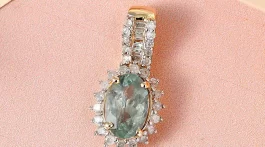Today, we will start an exciting journey to explore the delightful world of two incredibly enchanting gemstones – alexandrite and tanzanite. From royals to fashion-forward individuals, jewels hold a special place in everyone’s hearts due to their captivating beauty and unique characteristics. But let’s face it, while every gemstone has its charm, it’s crucial to understand their differences, especially when they are as mesmerizing as alexandrite and tanzanite.

The charm of these two gemstones lies much more profound than their captivating colors. By understanding the differences between alexandrite and tanzanite, we can better appreciate their uniqueness, contributing to the joy we experience when we wear or gift a piece of jewelry that features these stones. So, let us dive in and explore these wonders of nature!
Here’s to uncovering the wonders and mysteries of alexandrite and tanzanite!
Color: Alexandrite vs. Tanzanite
If you’re a color enthusiast, Let’s unwrap the extraordinary color palette these gemstones offer.
Alexandrite and tanzanite are gemstones known for their captivating colors and optical properties. Alexandrite, often likened to an artist’s dream palette, showcases a remarkable play of colors that transforms depending on the light. In daylight, it dazzles with a vibrant green hue reminiscent of emeralds. However, this gemstone undergoes a magical metamorphosis indoors, revealing a stunning purplish-red shade akin to a ruby. This fascinating phenomenon is aptly named the “alexandrite effect,” earning it the poetic description of “emerald by day, ruby by night.”

On the other hand, tanzanite possesses a different kind of allure. While not as dramatic as alexandrite, it still captivates with its range of blues, ranging from deep ultramarine to delicate violet blue. Tanzanite exhibits pleochroism, showcasing varying colors when viewed from different angles. This fascinating display adds to its allure, creating a mesmerizing gemstone that enchants with its intense blues and hints of violet, captivating the beholder’s gaze.
Distinguishing Alexandrite and Tanzanite
Alexandrite and tanzanite may appear similar, but fear not; we have some fantastic hints to help you differentiate between these captivating gemstones.
Color Change And Pleochroism
Watch for their chameleon-like tendencies. Alexandrite transforms remarkably from green in daylight to purplish red under incandescent light. In contrast, tanzanite has slight variation under different lighting conditions.
Tanzanite takes the spotlight when it comes to pleochroism. When observed from various angles, tanzanite reveals a captivating play of colors, ranging from intense blue to light violet. This phenomenon is not very pronounced in alexandrite.
Refractive Index and Specific Gravity
For those who enjoy a scientific touch, measuring the refractive index and specific gravity can provide valuable clues. Alexandrite boasts a higher refractive index and specific gravity than tanzanite, offering a distinct disparity in its optical properties.
The Allure of Alexandrite and Tanzanite
In the enchanting world of gemstones, rarity and value are the captivating plots that keep us spellbound. Let’s embark on a journey into the realm of alexandrite and tanzanite, where rarity takes center stage. At the same time, value adds a touch of allure to these remarkable gems.
Like a rare and elusive beauty, alexandrite possesses unparalleled scarcity. It is even rarer than diamonds, owing to its unique chemical composition and the precise conditions necessary for its formation. On the other hand, tanzanite, although not as rare as alexandrite, boasts an exceptional rarity of its own. It is mined only at one place near the Merelani Hills of Tanzania and offers an air of exclusivity.
Regarding value, fine-quality alexandrite commands a significant price due to its extreme rarity and mesmerizing color-changing properties. Alexandrite holds a prestigious position, often surpassing the value of diamonds and rubies of similar size. In contrast, tanzanite is generally more affordable. However, the value of high-quality stones with intense color and minimal inclusions can soar considerably.
Alexandrite: A Royal Discovery
Alexandrite was first found in the Ural Mountains of Russia. These remarkable gemstones are named after Tsar Alexander II. While the original Russian sources have waned over time, fear not! Emerging destinations such as Brazil, Sri Lanka, India, and East Africa have emerged as prominent suppliers of alexandrite in recent years.
Tanzanite: A Singular Treasure
The sole known source of tanzanite worldwide is in East Africa! Tanzanite was discovered in the 1960s near Mount Kilimanjaro. The fact that it can be found only in this place makes tanzanite a unique treasure, wouldn’t you agree?
Durability of Alexandrite and Tanzanite
Like a knight’s armor, a gemstone’s durability is critical. Let’s unveil their innate strengths and discover how to protect these precious gems.
Alexandrite proudly stands strong against wear and tear. Its hardness of 8.5 on the Mohs scale makes it a durable gemstone suitable for everyday wear.
Though breathtaking, Tanzanite showcases a slightly softer side with a rank of 6.5 to 7 on the Mohs scale. However, with proper care, your tanzanite jewelry will radiate brilliance for years.
Caring for Alexandrite and Tanzanite
Precious gemstones like alexandrite and tanzanite are admired for their exquisite beauty. Still, proper care and maintenance are essential to ensure longevity. To keep alexandrite’s sparkle intact, gentle cleaning with warm and soapy water with a soft cloth is recommended. Harsh chemicals and sudden temperature changes should be avoided to prevent any potential damage.
Tanzanite requires extra caution due to its lower hardness. Like alexandrite, tanzanite should be cleaned with warm soapy water and a soft cloth. Ultrasonic and steam cleaners, as well as harsh chemicals, should be avoided. Removing tanzanite jewelry during vigorous activities is advisable to prevent any potential damage.
Symbolism of Alexandrite and Tanzanite
Alexandrite, with its mystical color-changing properties, has long bewitched its admirers. It is often associated with good luck, fortune, and love, and its green hue represents growth and renewal.
In contrast, tanzanite is known as the stone of transformation. Its gorgeous blues and violets are believed to bring harmony and tranquillity, inspiring compassion and enhancing communication.
Choosing Between Alexandrite and Tanzanite
We’ve journeyed through the captivating realms of alexandrite and tanzanite, and now we stand at the end of our exploration. But before we part ways, let’s sum up our sparkling adventure and answer the ultimate question: how do we choose between alexandrite and tanzanite?
Suppose you’re fascinated by the magic of color change and drawn to the allure of rarity. In that case, alexandrite might be your gemstone soulmate. For those who adore a unique color palette, tanzanite is an excellent choice. Though a bit softer and requiring careful handling, tanzanite offers a more affordable alternative to alexandrite without compromising its beauty and symbolism.
Remember, the choice between alexandrite and tanzanite ultimately boils down to your preference and budget. Both are beautiful, both are unique, and both carry their charm and stories. So, whichever you choose, rest assured that you’ll have a gemstone that’s nothing short of extraordinary!
Begin your own gemstone journey with Shop LC!





No Comment